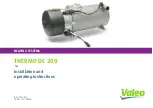
1.2
Precautions and warnings regarding
your installation.
1.2.1
The outside unit
The outside unit contains the equipment for
capturing energy from the ambient air.
Your installer has placed this unit in a location that
enables it to operate in an optimum manner.
Nothing should obstruct the air circulation through
the evaporator and from the fan.
The ambient air is cooled in the outside unit in
contact with an exchanger. The water that the air
contains condenses and flows from the outdoor unit.
In cold periods, this water freezes in contact with the
exchanger and is drained away by regular defrosting
cycles. The control system automatically controls the
defrosting cycle, whose operation can lead to the
quite normal emission of steam.
1.2.2
The hydraulic unit
The hydraulic unit contains the heat pump complete
control system, in charge of controlling the heating
comfort level and the production of domestic hot
water (if a DHW tank is connected).
The hydraulic module is equipped with an electric
back-up system, which is designed to provide
additional heat during the coldest periods.
1.2.3
Control system
Your installer has carefully adjusted your installation.
Do not modify setting parameters without his
agreement. If in doubt, do not hesitate to contact him.
The control system for your heating system is
designed:
-
either as a fixed flow temperature for the water (only
for low temperature radiators with thermostatic
valve controls).
-
Or as a flow temperature for the water based on the
external temperature (water control) with the
installation of an ambient air sensor (option).
This second solution (water control) is the only one
usable for Floor-heating systems. It is also very
effective for thermostatically controlled radiators.
1.2.4
Floor-heating systems
•
New floor-heating systems require to be initially
heated slowly to avoid any problems with cracking.
Check with your installer that this initial heating
procedure has indeed been performed before using
your heating system freely.
•
To be efficient, floor-heating systems do not need to
be very hot and never should be. At most, the
systems should be warm to the touch in cold
weather.
•
The great stability in a regulation system for
floor-heating systems avoids sharp differences in
temperature. However, this stability involves a
reaction time of the order of several hours, (approx
6 hours).
•
Any changes to the setting must be made slowly,
leaving the installation time to react. Adjusting the
system to exaggerated setting or in an untimely
manner always results in significant temperature
fluctuations during course of the day.
•
Similarly if your dwelling has a floor-heating system,
do not reduce the heating or switch it off if you will be
absent for a short period. The reheating period is
always quite long (approx 6 hours).
1.2.5
Domestic hot water (DHW)
This function is designed as an option through the
use of a DHW tank with electrical backup heating.
When the DHW production is required, the heat
pump adapts to this demand as a priority.
No space heating is produced while the domestic hot
water is being prepared.
The heat pump produces the domestic hot water,
which is then supplemented, if required, by electrical
backup heating inside the tank.
The electrical backup heating enables anti-legionella
cycles to be conducted efficiently.
4
Instruction manual “1353-EN”
Heat pump, split, single service


































